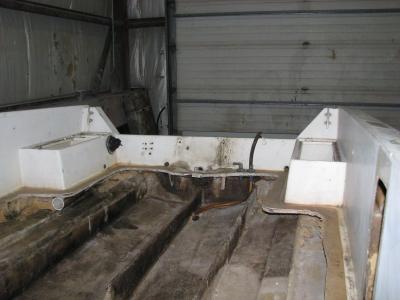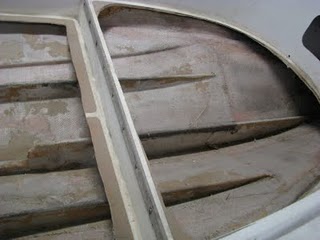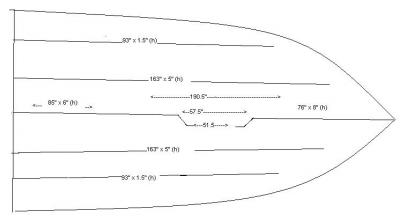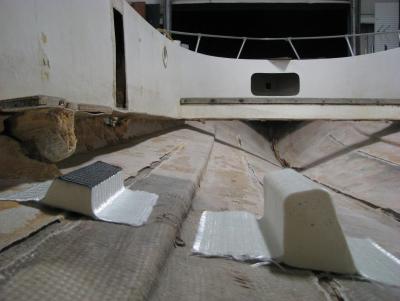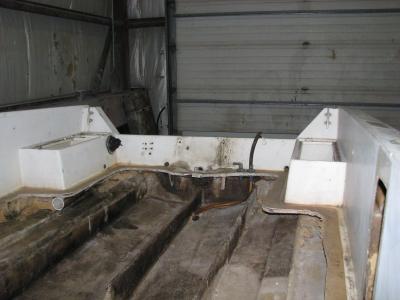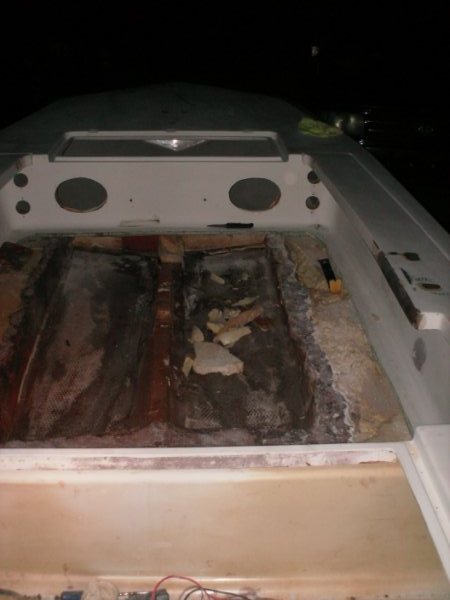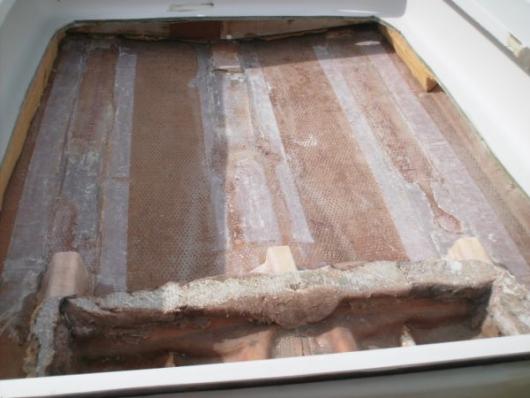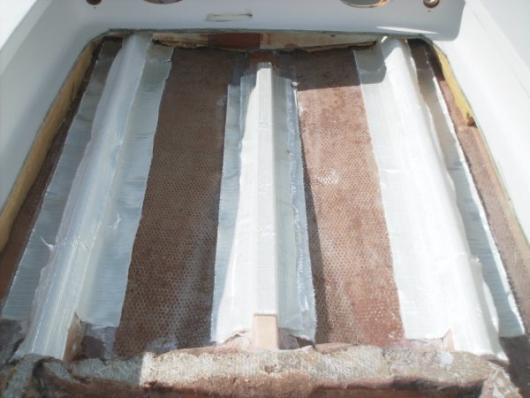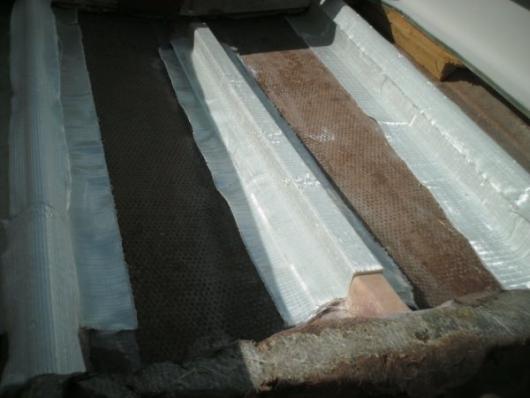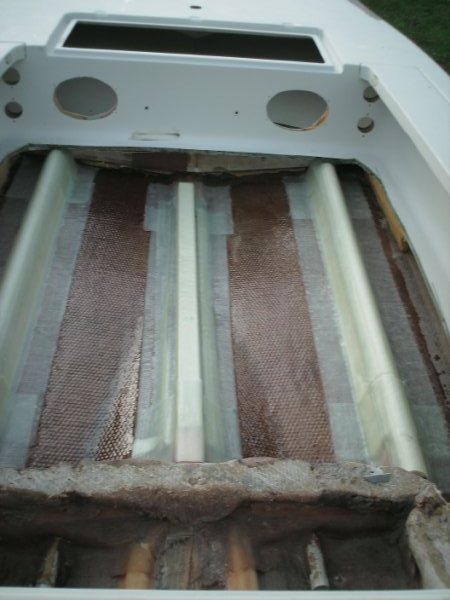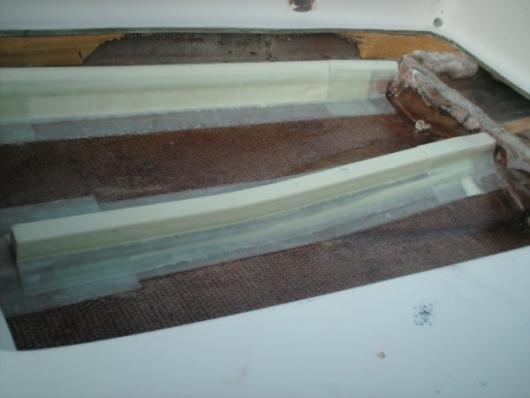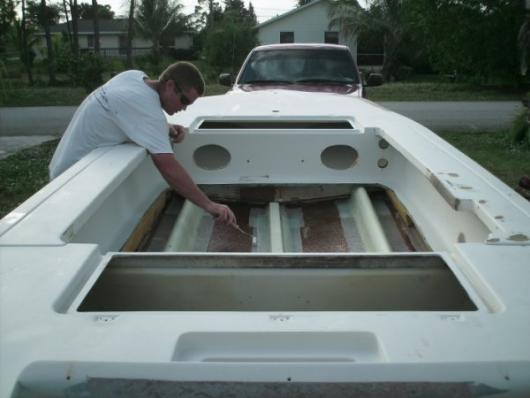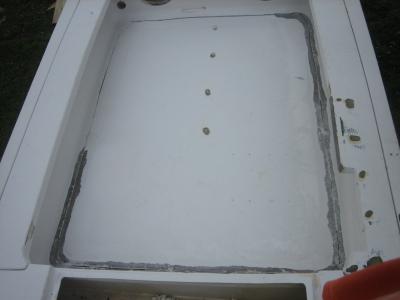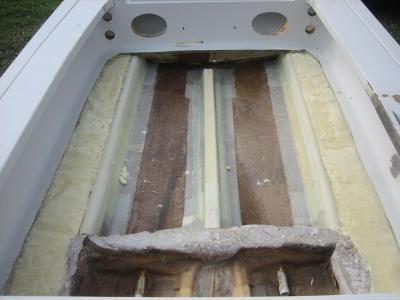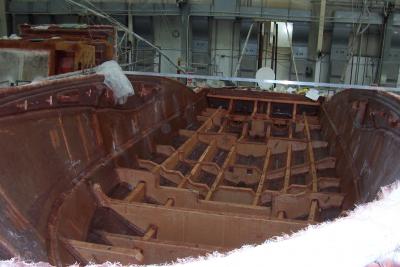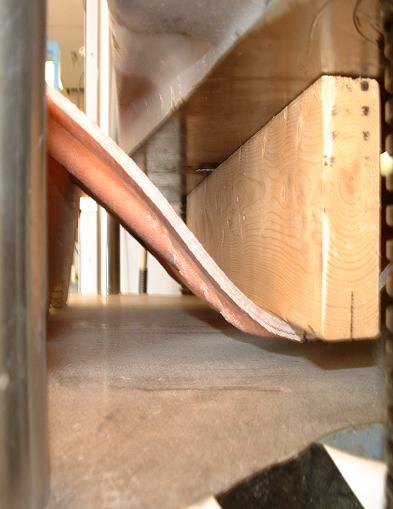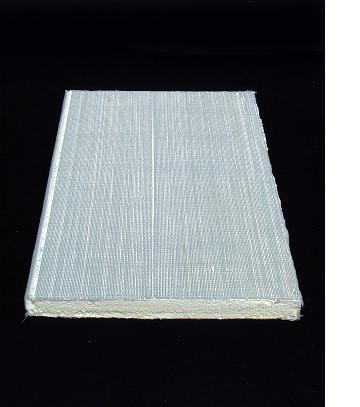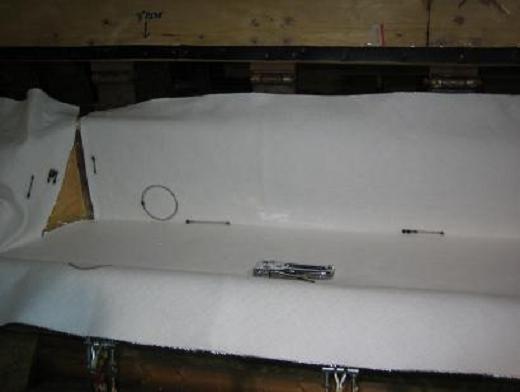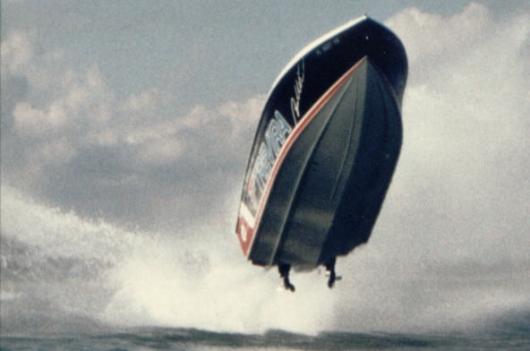 |
Welcome to the Reel Boating Forum.
From Trailer Boaters to Captains to Marine Industry Professionals, the Reel Boating Forum welcomes you to join in with other boaters and fishermen discussing topics including sportfishing, marine electronics, boating safety, boat engines and more. Use our FREE boat classifieds to sell your boat or fishing gear. Marine Industry Vendors are also welcome to register a username and freely post their products or services |
-
Posts
29 -
Joined
-
Last visited
Content Type
Profiles
Forums
Events
Everything posted by slewit
-
Hello Reelboaters I am starting a new project with Jamestown Distributors. We are restoring a 16 foot 1972 Mako boat. The hull laminate is in good condition, but as with many boats built with wood stringers, they have rotted over time. I will document the repair as it happens. The boat is owned by a couple of the guys at Jamestown. They will also document the effort and put this as a training guide on their website. I am treating this job just as I would anyone who contacts me and wants to replace or restore there composite structure. You will find a previous thread on reelboating where we discuss the repair of a pathfinder stringer. (search pathfinder and it will come up). As I posted the project, I had some comments that stringers always need to contact the deck. This is the case in the vast majority of boats 30 foot and under. However it is not the only approach. We have designed off shore race boats, stunt boats and combatant craft boats with suspended cockpits. The idea is to float the cockpit so that slamming loads are not transmitted though he hull into the stringer into the deck and into your body ! With the suspended deck the deck now acts like a shock absorber. This project caught my eye as it is a 1972 boat that took advantage of the suspended cockpit approach to improve the ride. As you can imagine the beating you can get going fast in rough conditions in a 16 foot boat. By suspending the cockpit the ride is greatly improved. For me the project is very timely as I am in the middle of a Navy R&D project where we are suspending the cockpit on a Navy RIB. We are doing it to reduce weight (less structure needed) and to reduce shock to the crew. Here is a picture of the boat hull Note the large gap between the stringer top and the cut away gap. The cockpit floats about 5" above the stringers. Here is a picture forward The Jamestown guys sent me this layout to help work stringers After talking to TJ at Jamestown we decided on two of our standard Prisma stringer shapes. The suspended cockpit made the stringer selection much easier as we do not have to worry about landing the deck on the stringers. I sent TJ samples of the two stringers that I thought would work. Here they have cut out the old stringers and you can see the two Prisma preforms samples in position. Today we discussed cleaning up the hull laminate. The are areas where the stringers were that have some delamination. Also you can see some areas of delamination in the aft section. So the next task is to remove this damaged laminate and lay new glass with Epoxy resin. Once the bottom is prepared we can start to put the stringers in. So next week the hull prep is on the schedule followed soon after with the stringer install. Thanks much to TJ Harris, Product Manager at Jamestown distribution for sharing this project with everyone on REELBOATING ! Scott
-
Guys, I am starting a new boat project with Jamestown distributors, this one is interesting. It is a 1972 Mako 16 foot boat. The interesting aspect of this boat is that is has a completely suspended cockpit. It is reported that the builder did this to improve the ride performance, as you can imagine a 16 foot boat in rough conditions can beat you up. Suspending the cockpit damps the shock loads to the crew. I will start a new thread and document the job start to finish.
-
I have more pictures of the Pathfinder that Chris is working on. He has now reattached the Deck to the new Prisma Stringers. Here Chris has poured foam on the outboard side of the stringers. From Chris "I used West Systems Cab O Sil to get the desired height of the deck from stringers"1/2 inch". I let the cabosil dry without the deck on and sanded it down with a belt sander. After a couple of dry fits "flush" I mixed up more cabosil and set the deck into place. Just got done grinding the edge "as shown" and used bi axel tape with west systems epoxy. Im not a boat builder but I am confident that the it will ride better than new. Ill have more pictures In a week or two." Nice work Chris ! Scott
-
Hi Larry Hope you had a good week. Just wondering if the samples made it to you yet? Thanks Scott
-
Thanks Larry glad that made sense. Better in Fla today.. Sunny and starting to warm; 64 now. Your sample set was sent out Friday via UPS. You will find some small beam segments, T-Mat, Prisma glass samples and literature. If you see a shape you are interested in I can send you some larger samples. To wet out Prisma, flip the product over and back wet the T-Mat backing on the bottom and tabs of the preform. Then flip over into position. I recommend back wetting all knit fabrics. Much better to be pushing resin (and air) up though the reinforcement then trying to push resin down. Wetting the laminate surface prior to laying the material helps even more. Picture you are doing a large stringer. So now you would wet down the entire top of the preform and let the resin just soak into the fabric (you dont have to chase air bubbles on the preform as the foam is expanded into the inside T-Mat layer). You can brush or squeegee resin in if you like. While the resin is soaking on the preform, this is when you work the tabbing. You want to roll out the tabbing-- While you work the tabs resin soaks into the Prisma. The glass fabric becomes nearly clear and you can see the foam of the preform. Too dry- White fibers.. Too wet- Glossy finish. . In my class one technique recommend to boat builders who like to use a lot of resin is to leave a section of the boat dry while wetting out the bulk of the area. Backwet and use a bit of extra resin as that speeds the wetout process. Then take that excess resin and transfer it via a fuzzy roller to the reserved dry section of the boat. I find that builders who do this get nice quality laminates without wasting resin. I will be in Gulfport, MS Mon-Wed teaching the ABYC CBBC (Composite Boat Builder Certification) so the above was good practice for me. I will be at one of the large shipbuilders doing DOD composites. I should be able to get on line at night, time allowing. FYI- ABYC is looking at doing an open CBBC class 1Q 2010 for those that may be interested in learning more about composite boat building. I will post the date on Reelboating when they set it. abyc class desc.doc Have a great Sunday ! Scott
-
Hi Larry Good question. Splices are treated very similar to interconnections between bulkheads and stringers. You want to butt the two stringer segments together. You then need to place a layer of glass overlapping the joint onto both stringer segments. ABYC/Structural Composites and ACMA/CCT (both training programs for composites) Rule of thumb for E-Glass and boats is we want a minimum of 2-3" of overlap at the seams. This overlap rule applies not only to stringers and bulkheads but for tie ins and fabric layers. The fibers are doing the bulk of the load bearing. What we need to do is have an effective way to transfer the loads from one fabric layer to another. The overlap provides this transition. Loads transfer from one fabric layer to another at the overlap via the resin interface. This is why we need the generous overlap so that we do not over stress the resin bond. If the overlap was too short, lets say only 1/4 or 1/2 inch, it could put too much load on the resin bond and it could delaminate (break). I also get the question on what about the gap between the two segments. The gap is not a problem as long as it is not so large that the glass overlay can buckle into the gap. Think of scored core or spaces between sheets of core. In sandwich construction many times the scoring is just void (a problem for water migration but not loads). If you want to eliminate the gap you can putty the segments together at the foam. large boat w/preform stringers. Segments were sized so workers could easly handle the preforms. Tabbing ties part together. Same 2-3" overlap rule apples to stringer to bulkhead, stringer to hull and bulkhead to hull connections. The tabs on the preforms provide the overlap onto the hull. This overlap allows loads to travel into the stringer. As to the hardspot caused by the overlap, this is not an issue in these applications. The laminate will be twice as thick in the overlap area, but we are still only going from 24 oz to 48 oz of glass. Conventional grid stringer systems typically have much more glass. This extra material is not to carry boat loads but for processing purposes. The grid is laminated on a mold and needs to have ample structure to be demolded, trimmed, jigged and craned into the boat, bonded or laminated into position. Many builders then post inject foam. So in this case the grid needs more added thickness so that it does not distort when the foam is injected. The Prisma process is a total reversal of the grid process. Here we line pressure rated tools with Dry fabrics and inject the foam. Once the foam cures you have a nice strong lightweight preform, glass attached ready to install into the boat. So this allows the builder to put only the material needed for the structural loads into the boat. This saves time, weight and cost. I dont want to tout that our products are the only way to build boats, it is not. Many boats use a wide variety of structural systems with great results. We are one of several options. Our process is a bit unique and works well for many, but not for all. We are finding that as the industry moves to closed mold process the preform is more and more the missing link that allows the builder to infuse or VARTM (Vacuum Assisted Resin Transfer Molding) structure into the part. I hope this answered your question. Also on your professional work, our sister company Structural Composites Inc may be able to assist you when you see a job that has those risks that can keep you awake at night. Here we provide independent laboratory testing, Expert Support, Design and Engineering, and ABYC Composites Training. Happy to help if we can provide value, if we cannot do what you need we can refer you to someone who can help. Have a great Weekend... Raining cats and Dogs today in Melbourne Florida. Scott
-
You didn't hear me talk down Proline. They do build very good production boats. Better than most. I sure don't, that's why I build custom, one at a time, to a niche market. It's extremely difficult to build a good production boat at a price that the market will accept, while keeping quality high, costs contained and still make a profit. I applaud any company that can survive in todays market and turn out a good product. Certainly new technologies go a long way towards making this achievable. Companies that survive will have to be lean, flexible and innovative, and use materials such as those stringers that will lower labor and material costs while maintaining quality. Again, I was not questioning the Compsys product, just the method of repair in that PF. Thanks all for a good discussion, I wish you much success. Heck, I just hope you and I survive (in business) the next few years until this mess turns around! Larry Hi Larry Thank you.. I always like a lively and constructive discussion. I will send you out a sample kit of our products. I would like to get your thoughts on our "Prisma TA" product line. Here we custom produce to your exact height and dead rise angle. Parts are 3" thick and 8 ft long. Glass and tabs included. This product won the IBEX innovation award this year for best boat building product. The idea is to be able to supply custom product cost effectively for a single boat. So far I have been hearing that the price ends up not that different from wood and saves a lot of time and weight. I will include a TA sample. I would value your thoughts. BOB- PLEASE CHECK OUT THE ATTACHED "TA" PRESS RELEASE ! press release prisma ta.pdf PRISMA TA FINALrev.pdf Our TA line is named in honor of the late Tony Adams. Tony worked for us and started us in repair. He appeared on ship shape TV (see our website for link to youtube). Tony worked at Proline prior to working for us and he built my Proline 201. Tony was a lifelong dedicated boat builder who loved to see how innovation could improve boats. Scott
-
Hi Cracker Larry I have some older messages to respond to but since you are so quick I will respond to your comments. First- Your posts are very nice and you know how to use the features of the forum way better then me, so you are teaching me ! It says I exceeded my "quote" limit so look for Italic's below. Me too. I only use epoxy for boats. Polyester is best left to liesure suits. It's not even waterproof. The polyester in suits is thermoplastic polyester. For boat resin it is the thermoset polyester. Yes VE and epoxy resins are better. But by far most recreational boats are built with Polyester resin. The reason is cost. PE is less then half that of VE and 1/3 that of Epoxy. When used and designed for properly PE laminates will last a really long time. In all these repairs we are working we are seeing PE based hulls from the 60's and 70's The wood is gone, the engine is toast, but the laminate lives on. I once had an industry pro say "We need worms that eats fiberglass, our boats last too long, we need people to buy new boats ".. My boat is a polyester 94 proline 201, I am thinking I will be getting another 20 years of of this boat as it is in fine shape. The repair is a different situation. Here we really want Epoxy or VE as we need good bonding to the old laminate.
-
what about secondary bonding? Resin type? Glass type? How many layers? Does this stringer system have any inherent strength or does it get all its stifness and rigid form from the glass and resin chosen? It seems to have large radiuses where it meets hull? Why? I still dont understand why you would not want the stringer to go from the hull to the deck if possible? That way the hull stringer is supporting the deck and the deck stringer is supporting the hull.Those outboard stringers in the picture sure look to be running down hill also? AND NOT HIGH ENOUGH TO SUPPORT THE DECK? Why start a thread with no feed back? Especially for the betterment of Reel Boating forum Hi Bly what about secondary bonding? Resin type? Glass type? How many layers? Yes, repairs are 100% secondary bonding (at least on the first layer). Thus I highly recommend the use of Epoxy or Vinyl ester resin. I do not recommend standard polyester resin for repairs as it has poor secondary bonding. Primary (Chemical )bonding occurs Polyester, VE and epoxy resin when laminating wet on wet. Once Epoxy cures anything you add to it is secondary bonding (mechanical not chemical). With Polyester or VE resin you have primary bonding for a few days or a week at most. This is why production boat builders can skin/bulk/brace in a weeks time and not have to worry about secondary bonding. The chemical bonding sites go away with time. Most builders will rough the surface of a boat that has sat in production over the weekend to help improve secondary bonding. The glass on this preform is 24 oz/sqyd of oriented knit fabric. The fabric also has our special T-Mat backing. This is a high tensity thermoplastic fiber that helps impart toughness and damage tolerance. It is compatable with Polyester, VE and Epoxy. I believe the single layer of glass we provide on the preform was all Chris used. That is what is done in the new construction of this boat. Does this stringer system have any inherent strength or does it get all its stiffness and rigid form from the glass and resin chosen? The strength and stiffness the stringer imparts on the hull is from the shape of the stringer and the materials. The primary purpose is to support the hull. In many small boats it also doubles to support the deck. We want the glass to carry the load, not the foam. The foams job is to keep the glass in position and not buckle thus allowing the glass to do its job. We can alter the strength of a given stringer shape by changing the fabric orientations and/or changing the fiber orientations. An ideal stringer has +/- 45 oriented glass on the side wall to support shear loads and glass running along the top of the stringer to support bending loads. In the case of the boat where the stringer is bonded to the cockpit, the +/- 45 fabric is often all we need. Here the cockpit sole acts as a giant top to the stringer, so having 0 degree oriented fabric on the top of the stringer will not do too much. This requires that the deck be fully bonded to the stringers and bulkheads. The resin selection has a minor impact on strength and stiffness. However, you will get better fatigue and durability with Epoxy and VE resin. Also dont forget we are bonding to old laminate and need the adhesive quality of the resin so we dont debond. It seems to have large radiuses where it meets hull? Actually this is a really good feature. Think of the glass fibers as the highways of stress. They are the stiff material in the composite and will attract the loads. These stresses are transmitted nicely when the fibers are straight. So when we have a stringer to hull or bulkhead to hull connection we want a radius to reduce the stress concentration and give us a nice "off ramp" for the stresses. Sharp corners are undesirable in composites as the fiber is not effective at transferring the load. So instead of the fiber taking the load the resin takes the load, the resin is not strong thus sharp corners tend to lead to sites for cracking. I still dont understand why you would not want the stringer to go from the hull to the deck if possible? That way the hull stringer is supporting the deck and the deck stringer is supporting the hull.Those outboard stringers in the picture sure look to be running down hill also? AND NOT HIGH ENOUGH TO SUPPORT THE DECK? I think my previous posting on this thread addresses this. The cockpit is supported by the outboard stringers and is suspended over the tunnel stiffener. If it is not clear let me know and I will explain better. Why start a thread with no feed back? Especially for the betterment of Reel Boating forum Yes, this is my fault.. It has taken me 2 days to get back on. I wish my workload was such that I could do this all day but keeping a business floating in the boating industry in these tough times is more then a full time job. Just yesterday we lost two great companies and customers. Century boats and Caravel boats, both closed for good, some really good boat builders out of work. I THANK YOU FOR YOUR PATIENCE AND WILL TRY AND RESPOND WITHIN A DAY OR TWO OF POSTS. I DO HAVE HEAVY TRAVEL SCHEDULES AT TIMES AND WILL DO WHAT I CAN WHEN ON THE ROAD. I HOPE THAT MY LIMITED EXPERIENCE AND KNOWLEDGE OF COMPOSITES CAN HELP THOSE OF YOU THAT WANT TO LEARN AND UNDERSTAND HOW COMPOSITES WORK. IT IS A REALLY AMAZING FIELD TO WORK IN AN GOES WAY BEYOND BOATS. I LEARN AND GAIN EXPERIENCE EVERY DAY I WORK IN THIS INDUSTRY AND AM ALWAYS AMAZED AT WHAT A GOOD EXPERIENCED BOAT BUILDER CAN TECH ME. THANK YOU BLY SCOTT
-
Hi Larry As others have pointed out there really are many stringer designs. Your observation is very common on small boats. The Cockpit sole lands on the stringers. This is not the only way. We have done several race boats and stunt boats that have a suspended cockpit. I am working a Navy project now where we are suspending the cockpit for a combatant craft boat. In these applications we are trying to reduce the shock load that the operator and crew sees due to wave slamming. When the hull and deck are bonded together with the stringer you tend to get very high shock loads as the load path is from the hull bottom though the stringers into the cockpit and into your body. Think of steel wheels, no shocks or springs and a hard seat on a car, not a smooth ride ! By suspending the cockpit we now allow the hull, side and deck structure to act as a shock absorber. Shock loads have to travel though the hull bottom around the side of the boat around the gunnel down the tub deck to the cockpit. The result is large drop in G loads. You do not often find this on small boats or many recreational boats as the construction is simple and effective and we want the operator to feel the shock and SLOW DOWN.. i.e. you break before the boat does. This is not an option in Special Ops, Stunt boats or race boats, different mission ! Another example is in large boats. Once we get over 30-40 ft we no longer land the cockpit on stringers as we have cabins engine rooms etc.. We are using the internal space. Here is a picture of a Military Rib.. Note the low section frames. This also has a suspended cockpit and has no core materials. single skin rib.bmp Thank you for the comment Scott
-
Hi Guys Sorry I was attending The Defense Manufacturing Conference in Orlando and had no time to get on line.. Some really great comments and questions that I do owe you all answers on.. Sorry for the delay ! I will respond in a couple of postings as I can today.. From Bly What Kind of trailer accident? just loading a boat or a highway accident? Did the original stringers separate from the hull with out damaging the hull? I emailed Chris to get more specifics but have not heard back, here is what I do know. The boat came off the trailer, I dont know the failure mode he had but with Prisma our first failure mode is normally side wall bucking. What happens is the glass on the side of stringer buckles away from the foam, the compressive strength of the foam then kicks in and the glass buckles. This does not normally crack the glass as it is only a thin layer and can flex quite a bit. The result is reduced damage to the hull and deck and a noncatastrophic failure mode. With wood stringers and many grid stringers the stiffness is so high that the first mode of failure is either hull cracking and/or the stringer ripping out of the boat. Yes some builders do design boats like cars, designing for non-catastrophic failure could mean the difference between getting home or not and the difference between major or minor damage. Pathfinder is doing a good job in this regard. Prisma Beam under extreme flexural loading. Note the side wall buckling and large defection. Was the floatation foam part of the problem? was the floatation foam reinstalled before deck went down? Chris did not say but I expect it was not as the added foam in nonstructural. The stringers take the load. Chris has not re-decked yet. I hope to hear back from him on the email I sent. What supports the deck? the stringers do not look like they go high enough to support the deck? The glass laminate was put on top of the stringer foam? was vinylester resin used for a better secondary bonding? The Deck/Cockpit does land on the outboard stringers. The center stiffener is to strengthen the tunnel and does not contact the deck. It is to stiffen the tunnel/hull area. Prisma Preforms are supplied with the glass already attached. Some builders do add additional tabbing and cap glass and/or glass overlays when loading conditions demand this, typically larger boats. Chris used Epoxy Resin for this repair. I highly recommend Epoxy for repair as this provides the best bonding. The next best is Vinylester Resin. What kind of stringers were there before the accident? same type? Yes, this boat was built with PRISMA. So the replacements are exactly the same. I KNOW I OWE YOU ALL MORE ANSWERS.. AND I PROMISE TO GET THESE TO YOU WITHIN THE NEXT DAY OR SO.. SORRY BUT WITH THE ECONOMY THE WAY IT IS I HAVE TO DO THE WORK OF MANY.. ITS 7 DAYS A WEEK NOW.. SO THANK YOU FOR YOUR UNDERSTANDING. If any of you need immediate technical support you can contact me directly at 321 252 4566. Thank you all for participating in the discussion. SCOTT
-
Thanks to Chris Peters for the photo’s of his repair job on his 1998 Pathfinder boat. Chris’s boat was damaged in a trailer related accident. The result was he needed to replace the stringer system in the mid section of the boat. Here the deck has been removed, exposing the hull. Nice job removing the old stringers and getting ready to prep the laminate New Prisma Stringers are laid into position. Note how new Prisma preform stringers match up to the undamaged stringers. They are ready for wet out. Wet Out Stringers. Note how you can tell it is wet out as you now see though the Prisma Glass Great Choice selecting Epoxy for the Repair ! Notice how nicely the Prisma beam contours to the hull bottom. Giving it that final roll to make sure its perfect ! Nice work Chris ! Thank you Scott
-
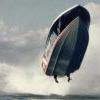
Repairing Replacing Composite Stringers, Bulkheads
slewit replied to slewit's topic in Boating and Fishing Discussion
Hi Mark Thank you for the feedback and the posting on the project forum. It really helps when people can see others use the product. As I said on the forum you are skilled at composites, nice work ! Happy that this worked out well for you and on the next boat lets discuss using our new PRISMA TA product for the stingers. These are 3" thick and produced to your height and dead rise angle. So a lot less customizing on your part. Thank you again ! Scott Lewit President Compsys, Inc. -
Hi Nitz Great Job on using our Compsys Prisma Preforms for this repair ! Your workmenship looks top knotch. We now also have a new custom stringer product "Prisma TA" this won the IBEX innovation award this year. You can see it on our website at www.preforms.com. Please let me know how the project turns out and feel free to contact me if you need help. I have a new deck planking product that I am working on and hope to have it ready for the market soon. I can send you a sample if you want to experiment. Also would you be OK with us posting this project on our website. Thank you Scott
-

Repairing Replacing Composite Stringers, Bulkheads
slewit replied to slewit's topic in Boating and Fishing Discussion
Yes we all the materials you need for stringer, bulkhead, and transom restoration. We also have special fiberglass fabrics and materials for lamination.. You will need to add the resin ! Please call me to discuss or send me your address and I will send you some free samples. 321-252-4566 slewit@aol.com Here is our newest product for repair. Tony Adams is in the YouTube video linked to our website. Unfortunately for the industry Tony passed away, but he is still teaching on this video that now has about 25,000 hits ! The product is in his memory- PRISMA TA. We just submitted this for IBEX's Innovation Award (our key industry trade show in Miami October 12-14). www.preforms.com PRISMA_TA.pdf Scott -

Repairing Replacing Composite Stringers, Bulkheads
slewit replied to slewit's topic in Boating and Fishing Discussion
Hi Bly Hope you are well. You are getting good prices for High Density (HD) core. But with all due respect it is much more costly then Prisma for the same application. Lets make a direct comparison. We sell a Prisma Panel. This is a panel 2 “ thick it is 24” wide and 48” tall. It is already encased in 24 oz/sqyd high quality knit E-Glass fabric. The list price for this panel is $42.12. Your panel is 4 x 8; so to be apples to apples we would need to provide 4 panels to give you the same coverage. So the price for this would be $168.48. So with your HD core you are paying a bit more, it is only ¾ thick and you still have to add the cost of fiberglass. Take a look at the price of 2” thick HD core and you will be looking at $350-$400 for a 4x8 sheet ! Even using the thin ¾ 20 lb board as a stinger your product before glass will be heaver then the Prisma stringer with glass. A couple of points. Our panel is 2lb/cuft density and 2” thick. The HD panel is ¾” and 20 lb/cuft, density. So the foam is 10 X higher density then Prisma. For stringers and bulkheads I believe the thicker panel is a better technical solution, For the stringer repair market we produce semi custom stringers 3” thick. The wider footprint distributes the load over a larger area of the hull thus reducing stress concentrations that can lead to gel coat and laminate cracking. Also the wider stringer cap allows us develop greater strength and stiffness to better support hull loads. We like to have the stringer installed with a cap of 0/90 oriented high-tech knit fiberglass tape over the top of the stringers and bulkheads. Many also appreciate the 3” cap as it proves a great landing for the deck and simplifies making deck panels. The HD Core in the 20lb range that you are using for stingers and bulkheads is an excellent choice for Transoms and locations where you want good screw retention. We use HD core and other materials within our OEM stringers. These are located by CNC Fabric cutters that draw the location of wood and pipe onto our production parts. This way we are only putting the heaver more expensive materials where we need it. The picture below shows the CNC cut fabric in a tool. The circle locates a cross pipe that is located in the stringer prior to foaming. Bye, If you like, please send me your address and I will send you some free samples of our product so you can try it first hand. As you are well versed in Composites, I would be interested in your opinion after you play with it first hand. Thank You. Scott -

Repairing Replacing Composite Stringers, Bulkheads
slewit replied to slewit's topic in Boating and Fishing Discussion
Interesting as we sell HD core also. What price data are you using? Thanks Scott -

Repairing Replacing Composite Stringers, Bulkheads
slewit replied to slewit's topic in Boating and Fishing Discussion
Hello Truklodyte High Density foam is a great option. Done properly it will do a fine job that is for sure. Cost, Increased Labor and increased weight would be the downside. In Prisma we use 2 lb density floatation grade foam. The result is we can often supply a product with glass for less cost then the bare high density foam. Our repair product line will feature 3” thick stringers and bulkheads. The wider footprint helps better divide the hull panels. The stringers get a 0/90 fabric on the cap so the 3” top provides better hull support then a thinner bulkhead. The 3” cap also helps provide a generous landing for the cockpit sole. The load bearing capability of our products come from the glass, as it should be! The foams job is to keep the glass in position and not buckle. Specially formulated tough non-friable low-density foam is used in our product. We have found the tougher foam formulations to impart the best durability onto boats. Many Go-Fast Builders such as Sea Hunter, Cigarette Racing Team and Scarab use our products for this very reason. They are looking for lightweight performance but need the durability to handle extreme environments. As to Screw holding. May I suggest you try a product we carry called Trevira. This is a polyester mat that can be laminated. It has many uses, one of them being excellent screw holding capability. Many of the OEMS use this product in locations where screw retention is needed. With this approach you are only putting the screw material down in patches where needed allowing you to use lighter weight lower cost materials such as Prisma. This Picture is of me driving a 1989 Cigarette- The Trevira Bullet, This was the first boat built extensively with Trevira. For me it was my first boat I ever built as we just started Structural Composites and landed our first big commercial customer (Trevira). I learned lamination from the hard working Cubans on Thunder Row Miami. After we finished the boat the guys from Cigarette said “Looks good but it need some hard hours on it”. So Scott Smith (now Dragon Powerboat) trained me and the Trevira guys gave me the keys to the boat, all expenses paid ! Of the boat 250 hours I put about 200 of them on her. Craig Barry is a world-class race boat driver (also now with Dragon Powerboat) he was VP of Cigarette. Once he saw this picture, he purchased it and I was finally in the “Club”. Higher density foams are cost effective as a replacement for wood transoms and selected other applications. We do carry a line of high density foam so if you would like a price, please contact me. 321-252-4566 Also- Please look for our Banner Ad kicking off our repair product line. We hope to have it uploaded to ReelBoating very soon. Scott -

Repairing Replacing Composite Stringers, Bulkheads
slewit replied to slewit's topic in Boating and Fishing Discussion
Thanks OReely for the constructive input ! Scott -

Repairing Replacing Composite Stringers, Bulkheads
slewit replied to slewit's topic in Boating and Fishing Discussion
Hi Bly Sorry if I offended you.. I was not trying to comment on your particular skill level as I have no idea on your experience in redesigning and restoring boats. What I dont want to do is gloss over the complexities that can occur when you are doing a major reconfiguration such as going from an inboard to outboard. My safety at sea concern is that you have developed adquate structure in the transom and redirected the loads properly into the hull and stringer system to take the loads. The load paths for inboards are typically not the same as for outboards. A major transom failure at sea can not only result in a financial loss but in the worst case a loss of life. Working with the Major OEMS, I can tell you that they spend a great deal of engineering effort making sure that the boats we purchase are safe and structurally sound. As I have always said no product is for everyone. So I will wish you the best of luck on your rebuild. Thank you for your consideration. Scott -

Repairing Replacing Composite Stringers, Bulkheads
slewit replied to slewit's topic in Boating and Fishing Discussion
Yes- These are the more extensive rebuilds that need to factor in changes in not only weight but the impact of moving the weights around. Going from Inboard to Outboard can reduce overall weight, but also will shift the boats center of gravity... Also a change such as this can have a big impact on boat structure. You would need to really take a good look at the loads on the transom as the boat was probally not designed to have an big 4 stroke outboard hanging off of it... This is a job for an experienced yard or a very skilled back-yard builder. Scott -

Repairing Replacing Composite Stringers, Bulkheads
slewit replied to slewit's topic in Boating and Fishing Discussion
Mark Galloway If you are close by or if any of you are would like to Tour the Prisma factory please contact me. slewit@aol.com 321-252-4566. Scott -

Repairing Replacing Composite Stringers, Bulkheads
slewit replied to slewit's topic in Boating and Fishing Discussion
Hi DownIntheKeys Great question ! In the case of a rebuild we should look at the weight of the materials you are pulling out vs. what you are putting in. In most cases we are replacing wood stringers with lighter weight composite stringers. In a 20-24ft boat you would see perhaps 200lbs of reduced weight. Where we get the big weight reductions is when a boat is designed from the beginning for Prisma stringers. We do this all the time supporting the major OEM's builders. With wood stringers we are attaching a very thin and very rigid frame on the hull. This results in an abrupt and sudden change in stiffness in the hull bottom near the stringer. Boats with wood stringers will typically have thicker hull laminates to deal with the stress concentration and the larger span between supports (stringers). Often when a wood stringer hulls are subjected to extreme loading it is common to find crack lines in the hull gel coat and/or laminate that run parallel to the stringers. Prisma stringers provide a wider footprint. These wider foot print stringers allow the boat designers to remove thickness out of the hull laminate. We can do this because the composite preform distributes the loads better giving a softer landing and its wider footprint results in shorter unsupported spans. This combination allows the builder to reduce the hull thickness and save weight. These weight reduction can be significant enough to that a smaller engine can be used or a trailer with one less axle. (see attachment for flyer we give the OEMS for the boat owner). So as you see the OEM’s are really in the best position to save weight. As part of the design process the boat designer would be evaluating the placement and type of propulsion the boat should have. In today’s economic environment most of the OEM’s have figured out that reduction in weight offers many advantages. We have one OEM that made it a business focus to reduce weight and cost and created a lightweight series of boats from their standard boat line. The same 20 foot hull that had a 150 HP outboard now had a 115HP outboard. The result was a boat that was over $10,000 less expensive has better fuel efficiency and gives effectively the same performance. I think with gas prices and the cost of everything going up the builders the builders that focus on delivering innovation and value to the customer will be the winners. In your case, I suggest we consider the overall project. If you are simply going to replace the wood stringers and bulkheads with Prisma, the resulting weight savings may provide an opportunity to get somewhat better performance out of your boat by a change in prop pitch. I do not expect it would create enough of a change that would require you to rework your propulsion. When doing a more extensive job. For example, rebuilding the deck, adding large fish boxes, adding extensive storage, a pilot house, towers and the like then it would be advised to evaluate the change in weight along with closer evaluation of the structure and the impact the changes you are making are going to have on stability and performance. I hope this answers your question. Thank you Scott -

Repairing Replacing Composite Stringers, Bulkheads
slewit replied to slewit's topic in Boating and Fishing Discussion
Hello OReely Thank you for your message. Great Questions ! OEM boat builders use our product extensively. We currently sell to over 30 major brands and via distribution in the US and Europe. With the OEMs we have produced over 250,000 boats with the product since 1994. The common experience is the product provides the following: Reduced Weight (4-15% reduction in hull wt) Increased Durability Reduced Manufacturing Variance Elimination of Hull Warrantee Issues Reduced Labor (30-90% for stringer install) Increased throughput Rot-Prof Construction The above items are very important elements in today’s very competitive OEM market. In the last few years we have expanded our product line from just stringers and bulkheads to products the replace or eliminate core. Don’t get me wrong cored construction is great, however it is very unforgiving. If for example you do not get a complete bond on both sides of the core you loose the structural integrity of the sandwich construction. Also boat owners are more and more having issues with particular core materials that are prone to rotting when they get wet. Moving to our new technology of Prisma framed single skin construction; we can reduce weight, manufacturing risk and greatly increase the toughness of the structure. Some pictures are attached to show you what I am talking about. No one product is good for everyone or for every job. Our products are geared to quality builders that are looking for durability, ease of use and reduced weight. If you send me your address and I will send you out a small sample that you can play with. Thank you again for the great questions. Scott Lewit Prisma_vs_Sandwich_pic.bmp -

Repairing Replacing Composite Stringers, Bulkheads
slewit replied to slewit's topic in Boating and Fishing Discussion
deckkitpic1.bmpdeckkit2.bmp Hi Sam Thank you for passing on feedback on Prisma Preforms. I am very happy to hear that the product worked well for you. Ease of use and high quality are are primary objectives. If per chance you have a picture we can show potentail customers that would be great. Please let me know if I can help you in the future. Attached are two pictures of a cockpit sole of a new boat being built with the beam product. Here we are eliminating the core material completely. The result is lighter weight, lower cost and increased structure. You may also want to check out this utube video. It shows a stringer replacement. http://www.youtube.com/watch?v=7gY1ZJwIJAI Thanks again Scott Lewit President Compsys, Inc


